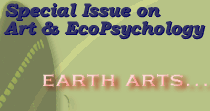

 |
 |
 |
 |
|
Introduction to the Earth Arts Section: Besides
what are often termed the ‘fine’ arts of painting, literature,
sculpture, theatre and dance, there are the ‘applied’
arts - ‘domestic’, ‘martial’ and ‘healing’
- that link us, in most cases much more directly, to the natural
world. EcoPsychology itself, as a therapeutic mode, is one of these
arts. Ancient
handcrafts like weaving, spinning and knitting work with the sheared
fleece of sheep, goats, rabbits and other animals, silk spun from
the bodies of silkworms, or the plant-derived cotton and linen -
material which was originally (and still is in some cases) colored
with dye from plants and minerals. Susan Gordon Lydon’s extraordinary
story in The Knitting Sutra is an exploration of the physical and
spiritual dimension of this popular art/craft. Excerpts from her
inspiring book can be found in this section’s review. The
cultivation of land and production of food are other arts with deep
roots in ancient earth-centered traditions. From humble backyard
gardening to full-scale small farming ventures producing vegetables,
grains, flowers, trees, and animal-based foods- the cultivation
and food arts are fundamental parts of our survival, and contribute
in countless ways to our life as human beings within the ecosystem
that supports us. Many
(if not most) ICE members are gardeners on some scale; we certainly
all participate in some aspect of this art (if only in eating the
result!). But few have developed it to the extent that Robert Greenway
and his family have on their small farm holding in the Puget Sound
region. Robert’s robust contribution to this issue, ‘The
Small Farm as Art Form: Thoughts on Applied Ecopsychology",
describes his ambitious farming project as an ongoing art-form in
process, illustrated with some remarkably beautiful photographs
of this modern Eden. In addition, I’ve included excerpts from
some of the many ICE conversations on the subject of gardening,
farmers' markets and making things by hand, along with a wonderfully
useful year-round garden artisan’s ‘how to’ guide,
submitted by thoughtful Michigan reader Ann Zalek. Time honored food arts such as cheese-making, bread-baking, wine making, and flower-arranging nourish our bodies and enhance our lives with their simple grace. The political culinary movement Slow Food, begun in Italy with the protest of a local man to the encroachment of McDonalds into his local economy, has quickly spread into an international organization that champions local cuisine and food production in communities all over the world. I've included material about this fascinating movement, excerpted from an article in Fast Company magazine, with some of the projects they support, and links to their website. Then
there are the healing arts, some of which have developed complex
understandings and medicinal applications tied to the same ancient
earth-connected philosophies of health and energy circulation that
inform many martial arts. Diet, herbology, acupuncture, acupressure,
and various forms of massage; all the healing arts of this type
have as their base a respect for the human body and the elements
of the natural world we are all made up of. Read more about this
in the excerpt from the introductory chapter of Diane Connelly’s
classic, Traditional Acupuncture: the Law of the Five Elements. And lastly, bringing this whole sphere of earth arts together and back to a direct application of the healing art of EcoPsychology, we have an experiential exercise offered by ICE member and EcoPsychology pioneer Micheal Cohen, taken from his vast body of applied work on this subject. |